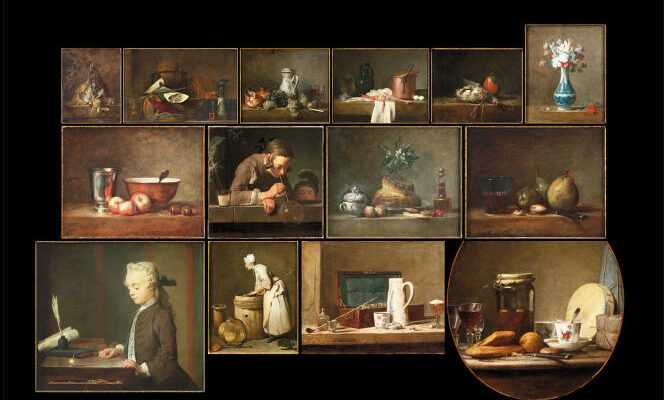“In my show, I present images to the public, including a wall made up of paintings by Chardin. The first, on the second row from the left, is The silver goblet, painted around 1768. When I discovered it, at the Grand-Palais during the Chardin retrospective, in 1979, I was 19, and it was a real revelation. It was just three objects and five fruits without decoration, without anecdotes, without symbols either. And that’s when I understood that painting was not graphics, that it was not images, that everything was in the painter’s touch and the pleasure it gave to contemplate things.
“I thought, and I still think, that a painting is not interesting if you read it like a rebus, putting concepts and symbols on images. That it takes away from the great ecstasy that painting provides. »
In this painting, you have to put yourself in the place of a fly that sees the melted reflections of the apples on the timpani or that climbs along the bowl before arriving at the abyss from which a beam emerges. Chardin gets down to fruit and takes us to the village of objects. There is an admirable blur on the inside walls of the bowl which makes the distances phenomenal. In short, it’s the kind of painting that confirmed my vocation: I’ll be an art critic! Which does not mean art historian – giving the context – or exegete – interpreting the images, no! My role is not to make people understand, but to make people love them, which is much more delicate.
I came from a very intellectual family but not at all interested in painting. To be passionate about Chardin, I hadn’t read Diderot or anything about still life or the 18th century.and century, convinced that it would be useless. My mother reminded me that I had gone so far as to solemnly announce to her: “I won’t pass the baccalaureate and I won’t go to university, because it would damage my vision of the art that I have to develop on my own!” My parents were devastated, but, finally, I passed the baccalaureate and went to the Ecole du Louvre, but I only stayed there for a year. I preferred to do philosophy, logic and aesthetics.
When I was 16, during my “study” holidays in Germany, I provided guided tours of the Munich art gallery for French tourists. My “explanations” were borrowed from the history of cinema, which I knew better. I compared the battles of the painter Altdorfer to scenes from the films of Abel Gance, the chiaroscuro of Rembrandt to that of Fritz Lang. The hidden meaning of the paintings, their resonance with society didn’t interest me, only the question of beauty obsessed me, and I haven’t changed that much. I thought, and I still think, that a painting is not interesting if you read it like a rebus, putting concepts and symbols on images. That it takes away from the great ecstasy that painting provides.
I don’t remember staying long in front of this work by Chardin, but I came back to it so many times in my life. A painting is not an essay that you have to understand, it’s just a beautiful verse that says it all and should carry you away. But beware ! It is not because I reject bookish culture from the political and historical context that I applaud the absence of culture. The sensitivity of the eye is also cultivated and it is the meaning of my life to transmit it. »
Exhibition at the Sabine Bayasli gallery, 99, rue du Temple, Paris 3andfrom April 30 to May 9.
The whole history of painting in less than two hours, Theater of the Workshop, 1, place Charles Dullin, Paris 18anduntil June.great-art.online
